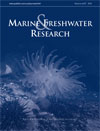Marine and Freshwater Research
Volume 64
Number 7 2013
Rivers of the wet–dry tropics can disconnect to isolated waterholes in the dry season and provide important refuges for plants and animals. This study examined the factors that affect algal growth in shallow waterholes in the wet–dry tropics and found that nitrogen was a key factor controlling algal growth. Future changes to water extraction and irrigation practices could impact negatively on these systems by stimulating algal bloom with flow-on effects for the food web.
This study provided the first estimates of exploitation rates for sea cucumbers harvested at Scott Reef, Australia, by traditional Indonesian fishers. Critically for management, exploitation rates on the shallow reef top were shown to be extreme. The removal methods used in the study should be applicable to many of the world’s intensively exploited and threatened sea cucumber fisheries, potentially helping to bring about better management.
An additive partitioning analyses was applied to assess biological diversity in reservoirs. The diversity of benthic macroinvertebrates was assessed at different spatial scales in three tropical Brazilian reservoirs. The distribution of benthic organisms was driven by local factors and the diversity was higher at lower levels.
Understanding relationships between hydrology and population dynamics will assist in restoring fish populations in regulated rivers. In the present study, we found that strong recruitment of golden perch, Macquaria ambigua ambigua, in the regulated lower River Murray followed spring–summer spawning when peak flows were >14 000 ML day–1 and water temperatures exceeded 20°C. Restoring within-channel flows of 15–25 000 ML day–1 from late spring through summer would promote spawning and recruitment and improve the resilience of golden perch populations in the lower Murray.
Cold-water corals are generally assumed to grow much slower than their tropical counterparts; however, slow growth of cold-water corals may be an artefact of ex situ culture conditions. Our growth experiment comparing in situ and laboratory specimens of Desmophyllum dianthus, revealed that corals within their natural habitat had three times higher growth rates compared with laboratory specimens. In situ rates of D. dianthus are in the same order of magnitude as of hermatypic tropical scleractinians.
Using Australia as a case study, we examined three global challenges for river management: first, to base management practice on ‘best available science’; second, to integrate discipline-bound knowledge within cross-disciplinary and trans-disciplinary approaches; and third, to achieve adaptive management based on monitoring and evaluation. A review of stream management literature showed that river restoration relies heavily on discipline-bound science and results of monitoring, evaluation and applications of adaptive management are poorly reported. Although river management has been transformed in recent decades, much remains to be done to create a holistic foundation for river restoration that links biophysical science to social science and economics.
This study characterised the response of phytoplankton to high-flow events in a sub-tropical system. Events increased nutrient loads and altered the location and size of the Chl a maxima, and the drivers of the response (nutrients, residence time and light) switched in time and space. A concept diagram of event dynamics in shallow sub-tropical systems is presented.
Growth of the Australian bonito Sarda australis was described for the first time. Growth was found to be fast yet seasonal, with fish reaching 30-cm fork length after 3 to 4 months and near cessation of growth during winter months. Growth was consistent with other members within the genus Sarda; however, greater understanding of the population dynamics and movement patterns of this species is required before more refined estimates can be made.




